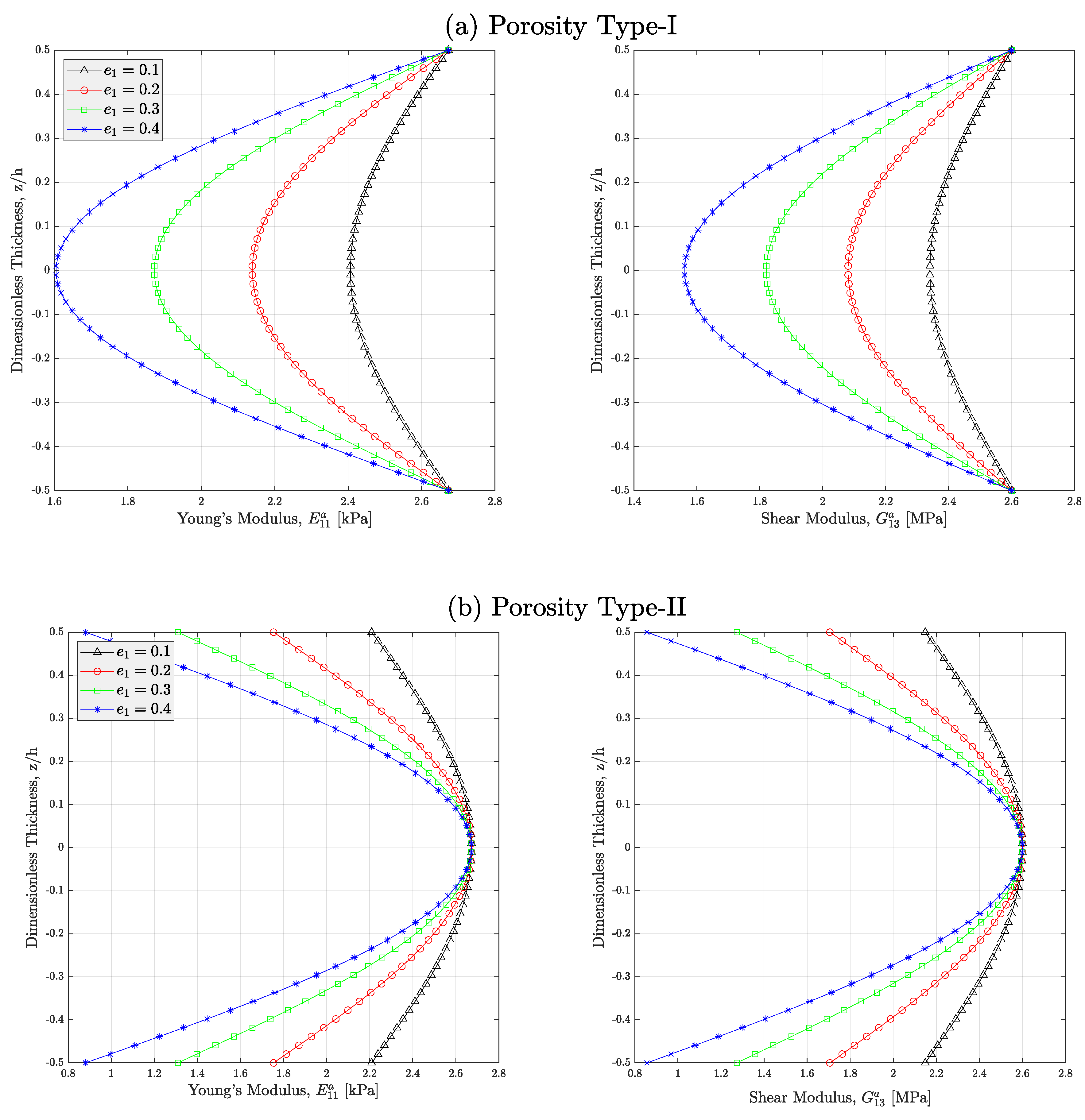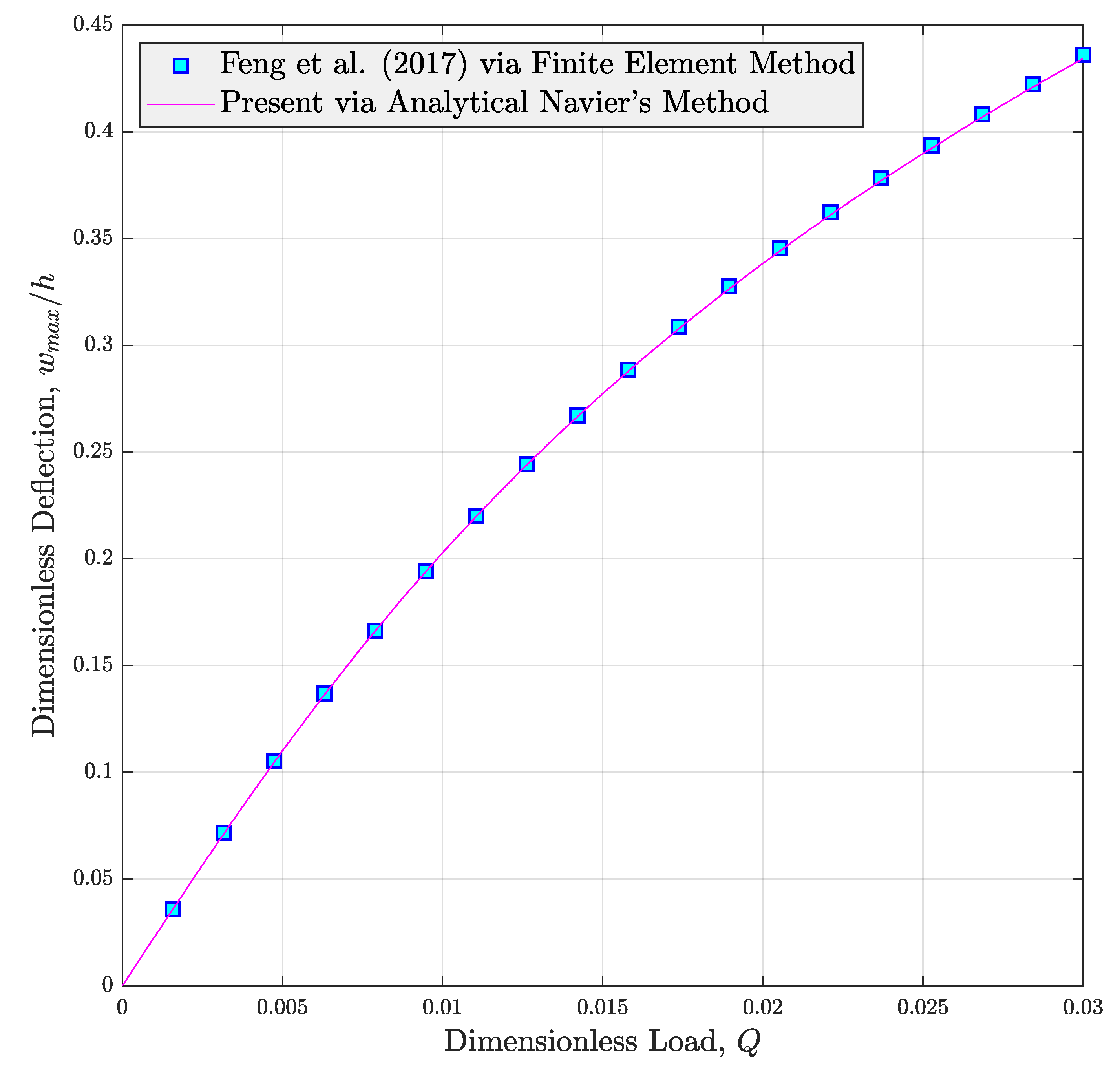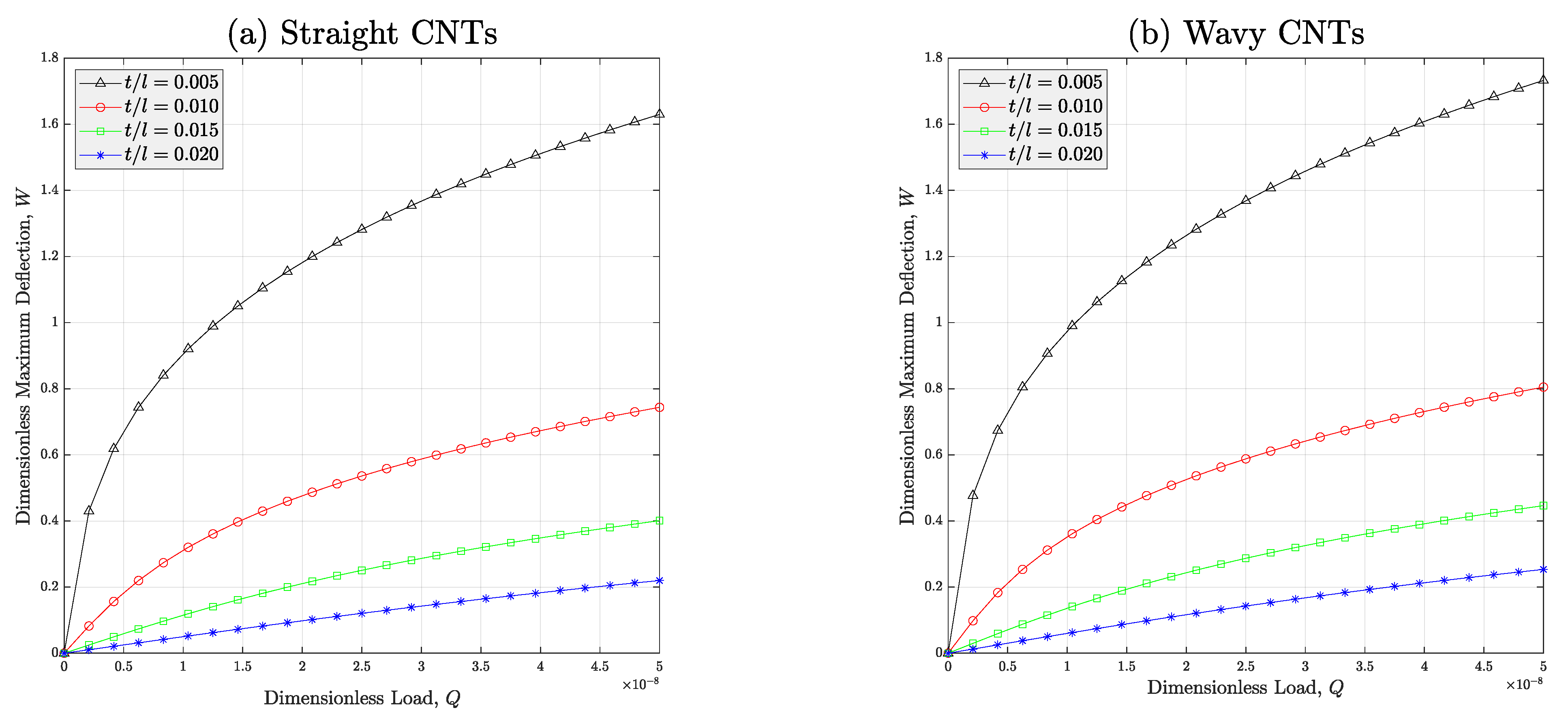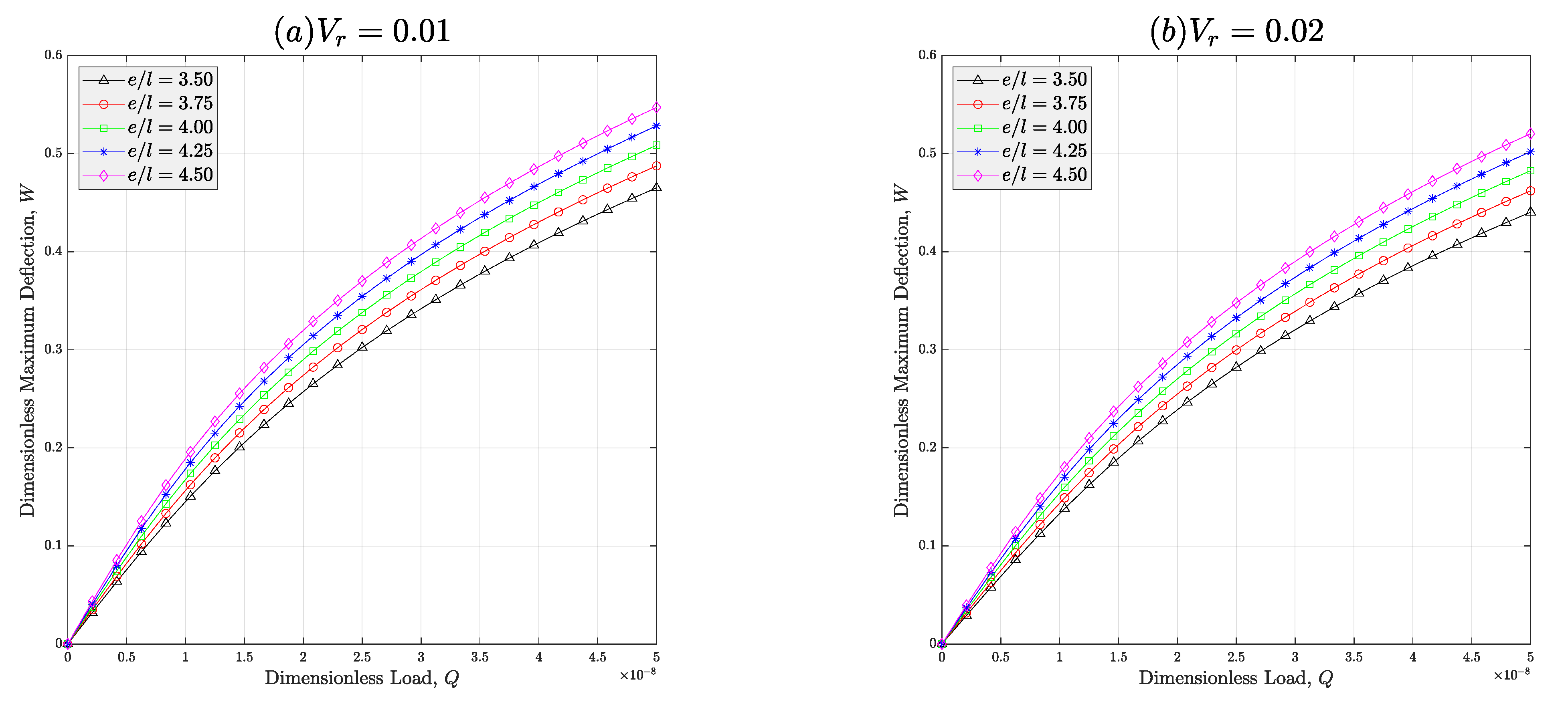Porosity Effects on Static Performance of Carbon Nanotube-Reinforced Meta-Nanocomposite Structures
Abstract
:1. Introduction
2. Theoretical Framework
2.1. Homogenization Method
2.2. Problem Kinematics
2.3. Governing Equations
3. Solution Procedure
4. Case Studies
5. Conclusions
- If a structure made from meta-nanocomposites is going to control the amplitude of its deflection, it is highly recommended to use lattices with great thicknesses.
- In reverse, if the design metric is to make the structure move with a high degree of flexibility, meta-nanocomposite materials with wider auxetic lattices are preferred.
- It should be kept in mind that the deflection of manufactured meta-nanocomposite beams is bigger than their calculated deflection because of the essence of curves in the CNTs which might be excluded in modeling.
- The manufacturers are seriously recommended to avoid the pores being positioned in close-to-edge zones of a meta-nanocomposite system.
Author Contributions
Funding
Informed Consent Statement
Data Availability Statement
Conflicts of Interest
References
- Baughman, R.H. Auxetic materials: Avoiding the shrink. Nature 2003, 425, 667. [Google Scholar] [CrossRef]
- Yang, H.; Ma, L. Design and characterization of axisymmetric auxetic metamaterials. Compos. Struct. 2020, 249, 112560. [Google Scholar] [CrossRef]
- Zhang, W.; Zhao, S.; Scarpa, F.; Wang, J.; Sun, R. In-plane mechanical behavior of novel auxetic hybrid metamaterials. Thin-Walled Struct. 2021, 159, 107191. [Google Scholar] [CrossRef]
- Donescu, S.; Chiroiu, V.; Munteanu, L. On the Young’s modulus of a auxetic composite structure. Mech. Res. Commun. 2009, 36, 294–301. [Google Scholar] [CrossRef]
- Assidi, M.; Ganghoffer, J.-F. Composites with auxetic inclusions showing both an auxetic behavior and enhancement of their mechanical properties. Compos. Struct. 2012, 94, 2373–2382. [Google Scholar] [CrossRef]
- Grima, J.N.; Cauchi, R.; Gatt, R.; Attard, D. Honeycomb composites with auxetic out-of-plane characteristics. Compos. Struct. 2013, 106, 150–159. [Google Scholar] [CrossRef]
- Kochmann, D.M.; Venturini, G.N. Homogenized mechanical properties of auxetic composite materials in finite-strain elasticity. Smart Mater. Struct. 2013, 22, 084004. [Google Scholar] [CrossRef]
- Hou, Y.; Neville, R.; Scarpa, F.; Remillat, C.; Gu, B.; Ruzzene, M. Graded conventional-auxetic Kirigami sandwich structures: Flatwise compression and edgewise loading. Compos. Part B Eng. 2014, 59, 33–42. [Google Scholar] [CrossRef]
- Mousanezhad, D.; Babaee, S.; Ebrahimi, H.; Ghosh, R.; Hamouda, A.S.; Bertoldi, K.; Vaziri, A. Hierarchical honeycomb auxetic metamaterials. Sci. Rep. 2015, 5, 18306. [Google Scholar] [CrossRef] [Green Version]
- Imbalzano, G.; Tran, P.; Ngo, T.D.; Lee, P.V.S. A numerical study of auxetic composite panels under blast loadings. Compos. Struct. 2016, 135, 339–352. [Google Scholar] [CrossRef]
- Jiang, L.; Gu, B.; Hu, H. Auxetic composite made with multilayer orthogonal structural reinforcement. Compos. Struct. 2016, 135, 23–29. [Google Scholar] [CrossRef]
- Jiang, L.; Hu, H. Low-velocity impact response of multilayer orthogonal structural composite with auxetic effect. Compos. Struct. 2017, 169, 62–68. [Google Scholar] [CrossRef]
- Fu, M.-H.; Chen, Y.; Hu, L.-L. A novel auxetic honeycomb with enhanced in-plane stiffness and buckling strength. Compos. Struct. 2017, 160, 574–585. [Google Scholar] [CrossRef]
- Ren, X.; Shen, J.; Tran, P.; Ngo, T.D.; Xie, Y.M. Design and characterisation of a tuneable 3D buckling-induced auxetic metamaterial. Mater. Des. 2018, 139, 336–342. [Google Scholar] [CrossRef]
- Gao, J.; Xue, H.; Gao, L.; Luo, Z. Topology optimization for auxetic metamaterials based on isogeometric analysis. Comput. Methods Appl. Mech. Eng. 2019, 352, 211–236. [Google Scholar] [CrossRef]
- Shoja-Senobar, M.; Etemadi, E.; Lezgy-Nazargah, M. An analytical investigation of elastic–plastic behaviors of 3D warp and woof auxetic structures. Int. J. Mech. Mater. Des. 2021, 17, 545–561. [Google Scholar] [CrossRef]
- Nguyen, D.D.; Pham, C.H. Nonlinear dynamic response and vibration of sandwich composite plates with negative Poisson’s ratio in auxetic honeycombs. J. Sandw. Struct. Mater. 2018, 20, 692–717. [Google Scholar] [CrossRef]
- Hajmohammad, M.H.; Nouri, A.H.; Zarei, M.S.; Kolahchi, R. A new numerical approach and visco-refined zigzag theory for blast analysis of auxetic honeycomb plates integrated by multiphase nanocomposite facesheets in hygrothermal environment. Eng. Comput. 2019, 35, 1141–1157. [Google Scholar] [CrossRef]
- Zhu, X.; Zhang, J.; Zhang, W.; Chen, J. Vibration frequencies and energies of an auxetic honeycomb sandwich plate. Mech. Adv. Mater. Struct. 2019, 26, 1951–1957. [Google Scholar] [CrossRef]
- Li, C.; Shen, H.-S.; Wang, H.; Yu, Z. Large amplitude vibration of sandwich plates with functionally graded auxetic 3D lattice core. Int. J. Mech. Sci. 2020, 174, 105472. [Google Scholar] [CrossRef]
- Wu, X.; Su, Y.; Shi, J. In-plane impact resistance enhancement with a graded cell-wall angle design for auxetic metamaterials. Compos. Struct. 2020, 247, 112451. [Google Scholar] [CrossRef]
- Cong, P.H.; Duc, N.D. Nonlinear dynamic analysis of porous eccentrically stiffened double curved shallow auxetic shells in thermal environments. Thin-Walled Struct. 2021, 163, 107748. [Google Scholar] [CrossRef]
- Ebrahimi, F.; Dabbagh, A. Mechanics of Nanocomposites: Homogenization and Analysis, 1st ed.; CRC Press: Boca Raton, FL, USA, 2020. [Google Scholar]
- Ebrahimi, F.; Nopour, R.; Dabbagh, A. Effects of polymer’s viscoelastic properties and curved shape of the CNTs on the dynamic response of hybrid nanocomposite beams. Waves Random Complex Media 2022, 1–18. [Google Scholar] [CrossRef]
- Ebrahimi, F.; Nopour, R.; Dabbagh, A. Effect of viscoelastic properties of polymer and wavy shape of the CNTs on the vibrational behaviors of CNT/glass fiber/polymer plates. Eng. Comput. 2022, 38, 4113–4126. [Google Scholar] [CrossRef]
- Nopour, R.; Ebrahimi, F.; Dabbagh, A.; Aghdam, M.M. Nonlinear forced vibrations of three-phase nanocomposite shells considering matrix rheological behavior and nano-fiber waviness. Eng. Comput. 2023, 39, 557–574. [Google Scholar] [CrossRef]
- Ebrahimi, F.; Nopour, R.; Dabbagh, A.; Duc, N.D. Vibration of three-phase hybrid viscoelastic nanocomposites beams. J. Mech. Sci. Technol. 2023, 37, 2311–2317. [Google Scholar] [CrossRef]
- Ebrahimi, F.; Nouraei, M.; Dabbagh, A.; Rabczuk, T. Thermal buckling analysis of embedded graphene-oxide powder-reinforced nanocomposite plates. Adv. Nano Res. 2019, 7, 293–310. [Google Scholar]
- Ebrahimi, F.; Dabbagh, A.; Rastgoo, A. Static stability analysis of multi-scale hybrid agglomerated nanocomposite shells. Mech. Based Des. Struct. Mach. 2023, 51, 501–517. [Google Scholar] [CrossRef]
- Ebrahimi, F.; Dabbagh, A.; Rastgoo, A.; Rabczuk, T. Agglomeration Effects on Static Stability Analysis of Multi-Scale Hybrid Nanocomposite Plates. Comput. Mater. Contin. 2020, 63, 41–64. [Google Scholar] [CrossRef]
- Amani, M.A.; Ebrahimi, F.; Dabbagh, A.; Rastgoo, A.; Nasiri, M.M. A machine learning-based model for the estimation of the temperature-dependent moduli of graphene oxide reinforced nanocomposites and its application in a thermally affected buckling analysis. Eng. Comput. 2021, 37, 2245–2255. [Google Scholar] [CrossRef]
- Dabbagh, A.; Rastgoo, A.; Ebrahimi, F. Static stability analysis of agglomerated multi-scale hybrid nanocomposites via a refined theory. Eng. Comput. 2021, 37, 2225–2244. [Google Scholar] [CrossRef]
- Dabbagh, A.; Rastgoo, A.; Ebrahimi, F. Post-buckling analysis of imperfect multi-scale hybrid nanocomposite beams rested on a nonlinear stiff substrate. Eng. Comput. 2022, 38, 301–314. [Google Scholar] [CrossRef]
- Feng, C.; Kitipornchai, S.; Yang, J. Nonlinear bending of polymer nanocomposite beams reinforced with non-uniformly distributed graphene platelets (GPLs). Compos. Part B Eng. 2017, 110, 132–140. [Google Scholar] [CrossRef]
- Liu, D.; Li, Z.; Kitipornchai, S.; Yang, J. Three-dimensional free vibration and bending analyses of functionally graded graphene nanoplatelets-reinforced nanocomposite annular plates. Compos. Struct. 2019, 229, 111453. [Google Scholar] [CrossRef]
- Polit, O.; Anant, C.; Anirudh, B.; Ganapathi, M. Functionally graded graphene reinforced porous nanocomposite curved beams: Bending and elastic stability using a higher-order model with thickness stretch effect. Compos. Part B Eng. 2019, 166, 310–327. [Google Scholar] [CrossRef]
- Anirudh, B.; Ben Zineb, T.; Polit, O.; Ganapathi, M.; Prateek, G. Nonlinear bending of porous curved beams reinforced by functionally graded nanocomposite graphene platelets applying an efficient shear flexible finite element approach. Int. J. Non-Linear Mech. 2020, 119, 103346. [Google Scholar] [CrossRef]
- Huang, X.-H.; Yang, J.; Wang, X.-E.; Azim, I. Combined analytical and numerical approach for auxetic FG-CNTRC plate subjected to a sudden load. Eng. Comput. 2020, 38, 55–70. [Google Scholar] [CrossRef]
- Shen, H.-S.; Xiang, Y. Effect of negative poisson’s ratio on the axially compressed postbuckling behavior of FG-GRMMC laminated cylindrical panels on elastic foundations. Thin-Walled Struct. 2020, 157, 107090. [Google Scholar] [CrossRef]
- Shen, H.-S.; Xiang, Y.; Reddy, J.N. Effect of negative Poisson’s ratio on the post-buckling behavior of FG-GRMMC laminated plates in thermal environments. Compos. Struct. 2020, 253, 112731. [Google Scholar] [CrossRef]
- Shen, H.-S.; Xiang, Y. Effect of negative Poisson’s ratio on the postbuckling behavior of axially compressed FG-GRMMC laminated cylindrical shells surrounded by an elastic medium. Eur. J. Mech. A/Solids 2021, 88, 104231. [Google Scholar] [CrossRef]
- Shen, H.-S.; Xiang, Y.; Reddy, J.N. Assessment of the effect of negative Poisson’s ratio on the thermal postbuckling of temperature dependent FG-GRMMC laminated cylindrical shells. Comput. Methods Appl. Mech. Eng. 2021, 376, 113664. [Google Scholar] [CrossRef]
- Shen, H.-S.; Li, C.; Huang, X.-H. Assessment of negative Poisson’s ratio effect on the postbuckling of pressure-loaded FG-CNTRC laminated cylindrical shells. Mech. Based Des. Struct. Mach. 2023, 51, 1856–1880. [Google Scholar] [CrossRef]
- Fan, Y.; Wang, Y. The effect of negative Poisson’s ratio on the low-velocity impact response of an auxetic nanocomposite laminate beam. Int. J. Mech. Mater. Des. 2021, 17, 153–169. [Google Scholar] [CrossRef]
- Dabbagh, A.; Ebrahimi, F. Postbuckling analysis of meta-nanocomposite beams by considering the CNTs’ agglomeration. Eur. Phys. J. Plus 2021, 136, 1168. [Google Scholar] [CrossRef]
- Lu, Y.; Biswas, M.C.; Guo, Z.; Jeon, J.-W.; Wujcik, E.K. Recent developments in bio-monitoring via advanced polymer nanocomposite-based wearable strain sensors. Biosens. Bioelectron. 2019, 123, 167–177. [Google Scholar] [CrossRef] [PubMed]
- Jiang, Y.; Liu, Z.; Matsuhisa, N.; Qi, D.; Leow, W.R.; Yang, H.; Yu, J.; Chen, G.; Liu, Y.; Wan, C.; et al. Auxetic Mechanical Metamaterials to Enhance Sensitivity of Stretchable Strain Sensors. Adv. Mater. 2018, 30, 1706589. [Google Scholar] [CrossRef] [PubMed]
- Ebrahimi, F.; Jafari, A.; Barati, M.R. Vibration analysis of magneto-electro-elastic heterogeneous porous material plates resting on elastic foundations. Thin-Walled Struct. 2017, 119, 33–46. [Google Scholar] [CrossRef]
- Eltaher, M.A.; Fouda, N.; El-midany, T.; Sadoun, A.M. Modified porosity model in analysis of functionally graded porous nanobeams. J. Braz. Soc. Mech. Sci. Eng. 2018, 40, 141. [Google Scholar] [CrossRef]
- Ebrahimi, F.; Dabbagh, A. A novel porosity-based homogenization scheme for propagation of waves in axially-excited FG nanobeams. Adv. Nano Res. 2019, 7, 379–390. [Google Scholar]
- Ebrahimi, F.; Dabbagh, A. Wave Propagation Analysis of Smart Nanostructures, 1st ed.; CRC Press: Boca Raton, FL, USA, 2019. [Google Scholar]
- Ebrahimi, F.; Dabbagh, A.; Rastgoo, A. Vibration analysis of porous metal foam shells rested on an elastic substrate. J. Strain Anal. Eng. Des. 2019, 54, 199–208. [Google Scholar] [CrossRef]
- Wang, Y.Q.; Ye, C.; Zu, J.W. Nonlinear vibration of metal foam cylindrical shells reinforced with graphene platelets. Aerosp. Sci. Technol. 2019, 85, 359–370. [Google Scholar] [CrossRef]
- Ebrahimi, F.; Dabbagh, A.; Taheri, M. Vibration analysis of porous metal foam plates rested on viscoelastic substrate. Eng. Comput. 2021, 37, 3727–3739. [Google Scholar] [CrossRef]
- Shi, D.-L.; Feng, X.-Q.; Huang, Y.Y.; Hwang, K.-C.; Gao, H. The Effect of Nanotube Waviness and Agglomeration on the Elastic Property of Carbon Nanotube-Reinforced Composites. J. Eng. Mater. Technol. 2004, 126, 250–257. [Google Scholar] [CrossRef] [Green Version]
- García-Macías, E.; Castro-Triguero, R. Coupled effect of CNT waviness and agglomeration: A case study of vibrational analysis of CNT/polymer skew plates. Compos. Struct. 2018, 193, 87–102. [Google Scholar] [CrossRef]
- Hassanzadeh-Aghdam, M.-K.; Ansari, R.; Darvizeh, A. Multi-stage micromechanical modeling of effective elastic properties of carbon fiber/carbon nanotube-reinforced polymer hybrid composites. Mech. Adv. Mater. Struct. 2019, 26, 2047–2061. [Google Scholar] [CrossRef]
- Arasteh, R.; Omidi, M.; Rousta, A.H.A.; Kazerooni, H. A Study on Effect of Waviness on Mechanical Properties of Multi-Walled Carbon Nanotube/Epoxy Composites Using Modified Halpin–Tsai Theory. J. Macromol. Sci. Part B 2011, 50, 2464–2480. [Google Scholar] [CrossRef]
- Ebrahimi, F.; Dabbagh, A.; Rabczuk, T. On wave dispersion characteristics of magnetostrictive sandwich nanoplates in thermal environments. Eur. J. Mech. -A/Solids 2021, 85, 104130. [Google Scholar] [CrossRef]
- Ebrahimi, F.; Dabbagh, A. Mechanics of Multiscale Hybrid Nanocomposites, 1st ed.; Elsevier: Amsterdam, The Netherlands, 2022. [Google Scholar]
- Ebrahimi, F.; Nopour, R.; Dabbagh, A. Smart laminates with an auxetic ply rested on visco-Pasternak medium: Active control of the system’s oscillation. Eng. Comput. 2023, 39, 221–231. [Google Scholar] [CrossRef]
- Reddy, J.N. A Simple Higher-Order Theory for Laminated Composite Plates. J. Appl. Mech. 1984, 51, 745–752. [Google Scholar] [CrossRef]
- Mirjavadi, S.S.; Mohasel Afshari, B.; Barati, M.R.; Hamouda, A.M.S. Transient response of porous inhomogeneous nanobeams due to various impulsive loads based on nonlocal strain gradient elasticity. Int. J. Mech. Mater. Des. 2020, 16, 57–68. [Google Scholar] [CrossRef]
- Ebrahimi, F.; Ghazali, M.; Dabbagh, A. Hygro-thermo-viscoelastic wave propagation analysis of FGM nanoshells via nonlocal strain gradient fractional time–space theory. Waves Random Complex Media 2022, 1–20. [Google Scholar] [CrossRef]
- Mirjavadi, S.S.; Forsat, M.; Barati, M.R.; Hamouda, A.M.S. Analysis of nonlinear vibrations of CNT- /fiberglass-reinforced multi-scale truncated conical shell segments. Mech. Based Des. Struct. Mach. 2022, 50, 2067–2083. [Google Scholar] [CrossRef]
- Mirjavadi, S.S.; Forsat, M.; Barati, M.R.; Hamouda, A.M.S. Geometrically nonlinear vibration analysis of eccentrically stiffened porous functionally graded annular spherical shell segments. Mech. Based Des. Struct. Mach. 2022, 50, 2206–2220. [Google Scholar] [CrossRef]
- Mohasel Afshari, B.; Mirjavadi, S.S.; Barati, M.R. Investigating nonlinear static behavior of hyperelastic plates using three-parameter hyperelastic model. Adv. Concr. Constr. 2022, 13, 377–384. [Google Scholar]
- Wang, L.; Hu, H. Flexural wave propagation in single-walled carbon nanotubes. Phys. Rev. B 2005, 71, 195412. [Google Scholar] [CrossRef]









Disclaimer/Publisher’s Note: The statements, opinions and data contained in all publications are solely those of the individual author(s) and contributor(s) and not of MDPI and/or the editor(s). MDPI and/or the editor(s) disclaim responsibility for any injury to people or property resulting from any ideas, methods, instructions or products referred to in the content. |
© 2023 by the authors. Licensee MDPI, Basel, Switzerland. This article is an open access article distributed under the terms and conditions of the Creative Commons Attribution (CC BY) license (https://creativecommons.org/licenses/by/4.0/).
Share and Cite
Ebrahimi, F.; Dabbagh, A. Porosity Effects on Static Performance of Carbon Nanotube-Reinforced Meta-Nanocomposite Structures. Micromachines 2023, 14, 1402. https://doi.org/10.3390/mi14071402
Ebrahimi F, Dabbagh A. Porosity Effects on Static Performance of Carbon Nanotube-Reinforced Meta-Nanocomposite Structures. Micromachines. 2023; 14(7):1402. https://doi.org/10.3390/mi14071402
Chicago/Turabian StyleEbrahimi, Farzad, and Ali Dabbagh. 2023. "Porosity Effects on Static Performance of Carbon Nanotube-Reinforced Meta-Nanocomposite Structures" Micromachines 14, no. 7: 1402. https://doi.org/10.3390/mi14071402







